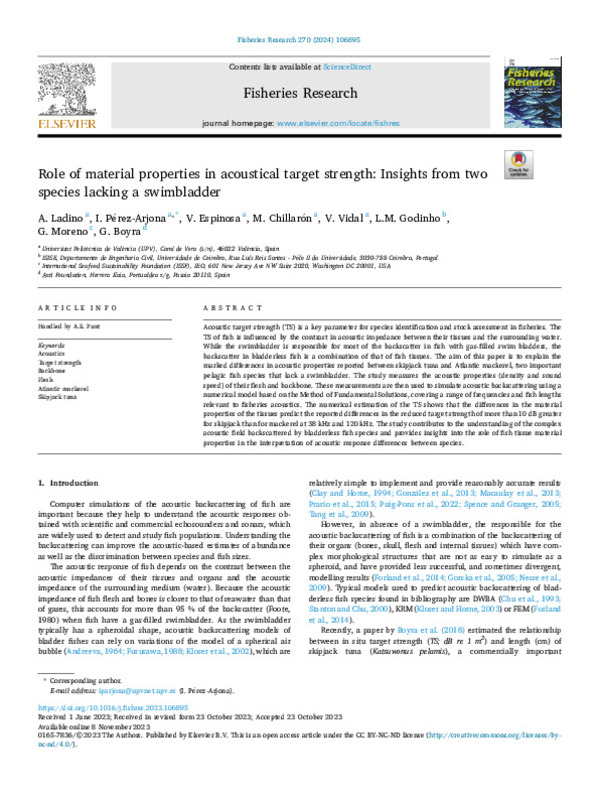JavaScript is disabled for your browser. Some features of this site may not work without it.
Buscar en RiuNet
Listar
Mi cuenta
Estadísticas
Ayuda RiuNet
Admin. UPV
Role of material properties in acoustical target strength: Insights from two species lacking a swimbladder
Mostrar el registro sencillo del ítem
Ficheros en el ítem
| dc.contributor.author | Ladino-Velásquez, Anderson
|
es_ES |
| dc.contributor.author | Pérez Arjona, Isabel
|
es_ES |
| dc.contributor.author | Espinosa Roselló, Víctor
|
es_ES |
| dc.contributor.author | CHILLARÓN-PÉREZ, MÓNICA
|
es_ES |
| dc.contributor.author | Vidal-Gimeno, Vicente-Emilio
|
es_ES |
| dc.contributor.author | GODINHO, LUIS
|
es_ES |
| dc.contributor.author | Moreno, G.
|
es_ES |
| dc.contributor.author | Boyra, G.
|
es_ES |
| dc.date.accessioned | 2024-02-08T19:03:25Z | |
| dc.date.available | 2024-02-08T19:03:25Z | |
| dc.date.issued | 2024-02 | es_ES |
| dc.identifier.issn | 0165-7836 | es_ES |
| dc.identifier.uri | http://hdl.handle.net/10251/202474 | |
| dc.description.abstract | [EN] Acoustic target strength (TS) is a key parameter for species identification and stock assessment in fisheries. The TS of fish is influenced by the contrast in acoustic impedance between their tissues and the surrounding water. While the swimbladder is responsible for most of the backscatter in fish with gas-filled swim bladders, the backscatter in bladderless fish is a combination of that of fish tissues. The aim of this paper is to explain the marked differences in acoustic properties reported between skipjack tuna and Atlantic mackerel, two important pelagic fish species that lack a swimbladder. The study measures the acoustic properties (density and sound speed) of their flesh and backbone. These measurements are then used to simulate acoustic backscattering using a numerical model based on the Method of Fundamental Solutions, covering a range of frequencies and fish lengths relevant to fisheries acoustics. The numerical estimation of the TS shows that the differences in the material properties of the tissues predict the reported differences in the reduced target strength of more than 10 dB greater for skipjack than for mackerel at 38 kHz and 120 kHz. The study contributes to the understanding of the complex acoustic field backscattered by bladderless fish species and provides insights into the role of fish tissue material properties in the interpretation of acoustic response differences between species. | es_ES |
| dc.description.sponsorship | This work was funded by MCIN/AEI/10.13039/501100011033/FEDER through the ACTHHUN project ref. PID2021-127426OB-C21 and by the International Seafood Sustainability Foundation (ISSF) and conducted independently by the authors. G. Moreno acknowledges the received funding under award NA19NMF4720214 from the 2019 Bycatch Reduction Engineering Program from National Oceanic and Atmospheric Administration (NOAA) . Funding for open access charge: MCIN/AEI/10.13039/501100011033/FEDER and Universitat Politecnica de Valencia. | es_ES |
| dc.language | Inglés | es_ES |
| dc.publisher | Elsevier | es_ES |
| dc.relation.ispartof | Fisheries Research | es_ES |
| dc.rights | Reconocimiento - No comercial - Sin obra derivada (by-nc-nd) | es_ES |
| dc.subject | Acoustics | es_ES |
| dc.subject | Target strength | es_ES |
| dc.subject | Backbone, Flesh | es_ES |
| dc.subject | Atlantic mackerel | es_ES |
| dc.subject | Skipjack tuna | es_ES |
| dc.subject.classification | FISICA APLICADA | es_ES |
| dc.subject.classification | CIENCIAS DE LA COMPUTACION E INTELIGENCIA ARTIFICIAL | es_ES |
| dc.title | Role of material properties in acoustical target strength: Insights from two species lacking a swimbladder | es_ES |
| dc.type | Artículo | es_ES |
| dc.identifier.doi | 10.1016/j.fishres.2023.106895 | es_ES |
| dc.relation.projectID | info:eu-repo/grantAgreement/AEI//PID2021-127426OB-C21//TECNICAS SONAR Y DE VISION POR COMPUTADOR PARA LA ESTIMACION DE BIOMASA Y CARACTERIZACION DE COMPORTAMIENTO DEL ATUN ROJO (THUNNUS)/ | es_ES |
| dc.relation.projectID | info:eu-repo/grantAgreement/NOAA//NA19NMF4720214/ | es_ES |
| dc.rights.accessRights | Abierto | es_ES |
| dc.contributor.affiliation | Universitat Politècnica de València. Escuela Politécnica Superior de Gandia - Escola Politècnica Superior de Gandia | es_ES |
| dc.contributor.affiliation | Universitat Politècnica de València. Departamento de Sistemas Informáticos y Computación - Departament de Sistemes Informàtics i Computació | es_ES |
| dc.contributor.affiliation | Universitat Politècnica de València. Escola Tècnica Superior d'Enginyeria Informàtica | es_ES |
| dc.description.bibliographicCitation | Ladino-Velásquez, A.; Pérez Arjona, I.; Espinosa Roselló, V.; Chillarón-Pérez, M.; Vidal-Gimeno, V.; Godinho, L.; Moreno, G.... (2024). Role of material properties in acoustical target strength: Insights from two species lacking a swimbladder. Fisheries Research. 270. https://doi.org/10.1016/j.fishres.2023.106895 | es_ES |
| dc.description.accrualMethod | S | es_ES |
| dc.relation.publisherversion | https://doi.org/10.1016/j.fishres.2023.106895 | es_ES |
| dc.type.version | info:eu-repo/semantics/publishedVersion | es_ES |
| dc.description.volume | 270 | es_ES |
| dc.relation.pasarela | S\503428 | es_ES |
| dc.contributor.funder | AGENCIA ESTATAL DE INVESTIGACION | es_ES |
| dc.contributor.funder | European Regional Development Fund | es_ES |
| dc.contributor.funder | Universitat Politècnica de València | es_ES |
| dc.contributor.funder | International Seafood Sustainability Foundation | es_ES |
| dc.contributor.funder | National Oceanic and Atmospheric Administration, EEUU | es_ES |
| dc.subject.ods | 12.- Garantizar las pautas de consumo y de producción sostenibles | es_ES |
| dc.subject.ods | 14.- Conservar y utilizar de forma sostenible los océanos, mares y recursos marinos para lograr el desarrollo sostenible | es_ES |








